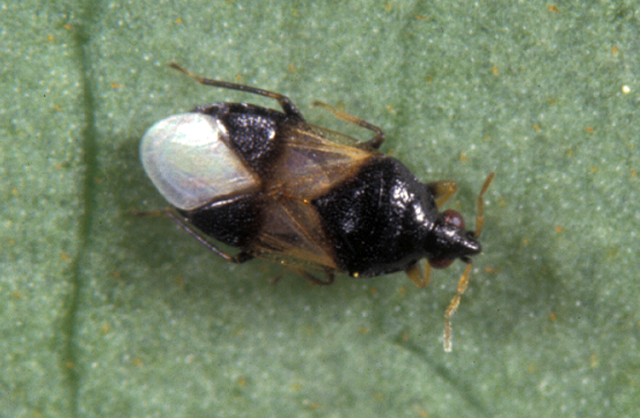Joe Funderburk, NFREC-UF/IFAS, Professor of Entomology
Megalurothrips is an Old World genus of thrips associated with the flowers of legumes (Fabaceae), with one species in Africa and twelve species in Asia. The Oriental bean thrips, Megalurothrips distalis, was first collected in Alabama, Florida, Georgia, South Carolina, and Tennessee in 2008. This is a large black species of thrips with adult females about 1/8 inch long. There are two larval instars with the second usually being pinkish in color. Early spring hosts in these states include various species of clovers and vetch. Flowering Kudzu is an excellent host during late spring and early summer. The introduction of Oriental bean thrips has significance for the production of beans in the southern United States as numerous bean varieties are important crops in the region. The bean thrips is reportedly an economically important pest of mung beans in Asia. Injury results in deformity or abortion of pods.
A field experiment was conducted in North Florida during the summer of 2013, and was repeated in the spring of 2014. The purpose was to evaluate the potential for damage to beans. Specifically, the abundance of Oriental bean thrips and the minute pirate bugs (Orius insidiosus) in the flowers of different species and cultivars of beans was determined. The minute pirate bug is an important predator of several flower thrips pests in Florida (Figure 1), and other species of minute pirate bugs are key predators of the Oriental bean thrips in Asia. Treatments for this field experiment included one cultivar each of southern pea, ‘Iron and Clay,’ edamame soybean ‘FL V44-2,’ and lima bean ‘Fordhook 242’. Five cultivars of the bean species Phaseolus vulgaris were also used as treatments. These cultivars were ‘Dwarf Horticultural Taylor Strain,’ ‘Jumbo OG,’ ‘Kenearly Yellow Eye,’ ‘Light Red Kidney,’ and ‘Midnight Black Turtle Soup.’

A population of Oriental bean thrips developed in the summer 2013 experiment, with high densities of adults and larvae in the flowers of some treatments on 5 and 12 September, respectively (Figure 2). There were significant differences between the bean species. There were no significant differences between the different Phaseolus vulgaris cultivars; therefore, only data for ‘Light Red Kidney’ are shown. Lima beans were the best host followed by the various cultivars of Phaseolus vulgaris, while southern peas and soybeans were not hosts. Populations of Oriental bean thrips did not develop in the 2014 spring experiment, with sample numbers very low on all sample dates. These results overall suggest that spring populations are low in North Florida, but buildup on alternative hosts are greater later in the summer.

The ‘Fordhook 242’ lima beans and the five cultivars of Phaseolus vulgaris beans were excellent hosts for minute pirate bugs. Their numbers correlated well with the numbers of Oriental bean thrips indicating that they were aggregating with their thrips prey. Southern pea ‘Iron and Clay’ and edamame soybean ‘FL V44-2’ were poor hosts for minute pirate bugs.
The results of these experiments showed that some bean crops are at risk in the southern US from Oriental bean thrips. Lima beans may be especially vulnerable; whereas, southern peas and soybeans may not be impacted. These experiments also showed that minute pirate bugs are key predators of thrips in beans.
Related links
Insidious Flower Bug, Minute Pirate Bug Orius insidiosus Say (Insecta: Hemiptera: Anthocoridae)
Megalurothrips distalis (Thysanoptera: Thripidae) Breeding in the Flowers of Kudzu in Florida
 0
0
